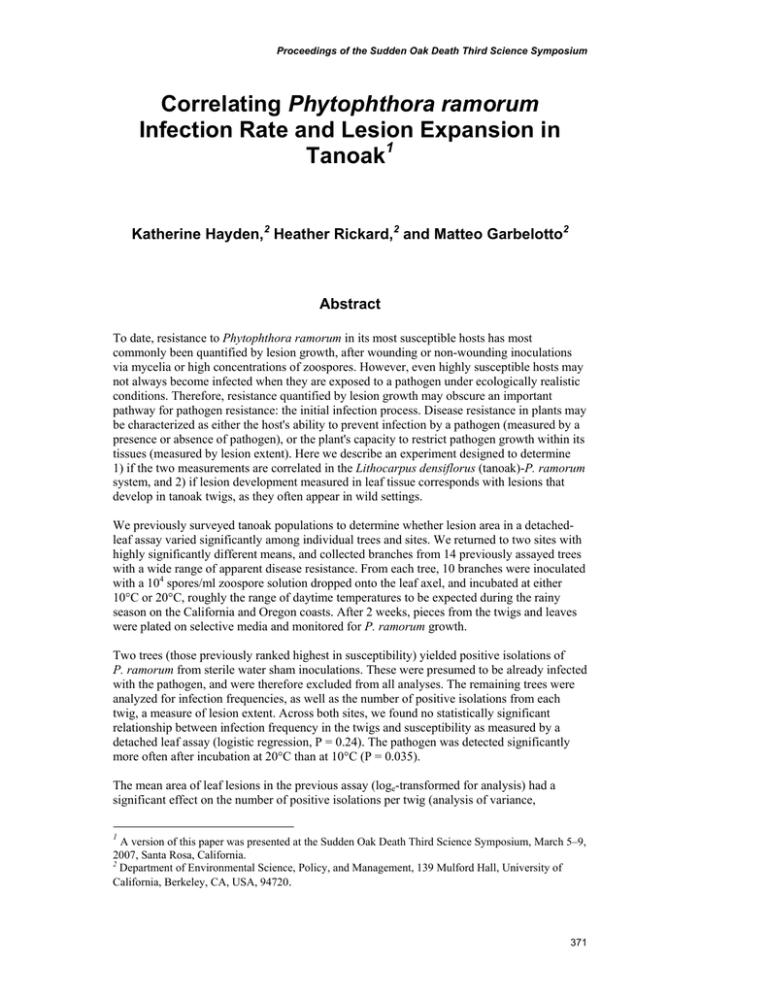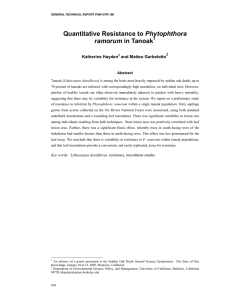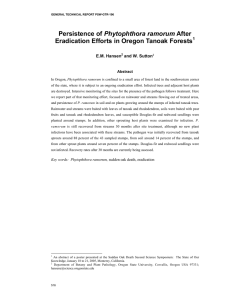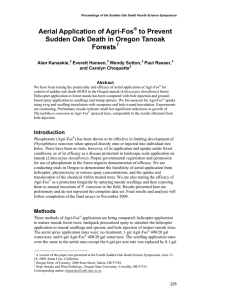Phytophthora ramorum Infection Rate and Lesion Expansion in Tanoak
advertisement

Proceedings of the Sudden Oak Death Third Science Symposium Correlating Phytophthora ramorum Infection Rate and Lesion Expansion in Tanoak1 Katherine Hayden,2 Heather Rickard,2 and Matteo Garbelotto2 Abstract To date, resistance to Phytophthora ramorum in its most susceptible hosts has most commonly been quantified by lesion growth, after wounding or non-wounding inoculations via mycelia or high concentrations of zoospores. However, even highly susceptible hosts may not always become infected when they are exposed to a pathogen under ecologically realistic conditions. Therefore, resistance quantified by lesion growth may obscure an important pathway for pathogen resistance: the initial infection process. Disease resistance in plants may be characterized as either the host's ability to prevent infection by a pathogen (measured by a presence or absence of pathogen), or the plant's capacity to restrict pathogen growth within its tissues (measured by lesion extent). Here we describe an experiment designed to determine 1) if the two measurements are correlated in the Lithocarpus densiflorus (tanoak)-P. ramorum system, and 2) if lesion development measured in leaf tissue corresponds with lesions that develop in tanoak twigs, as they often appear in wild settings. We previously surveyed tanoak populations to determine whether lesion area in a detachedleaf assay varied significantly among individual trees and sites. We returned to two sites with highly significantly different means, and collected branches from 14 previously assayed trees with a wide range of apparent disease resistance. From each tree, 10 branches were inoculated with a 104 spores/ml zoospore solution dropped onto the leaf axel, and incubated at either 10°C or 20°C, roughly the range of daytime temperatures to be expected during the rainy season on the California and Oregon coasts. After 2 weeks, pieces from the twigs and leaves were plated on selective media and monitored for P. ramorum growth. Two trees (those previously ranked highest in susceptibility) yielded positive isolations of P. ramorum from sterile water sham inoculations. These were presumed to be already infected with the pathogen, and were therefore excluded from all analyses. The remaining trees were analyzed for infection frequencies, as well as the number of positive isolations from each twig, a measure of lesion extent. Across both sites, we found no statistically significant relationship between infection frequency in the twigs and susceptibility as measured by a detached leaf assay (logistic regression, P = 0.24). The pathogen was detected significantly more often after incubation at 20°C than at 10°C (P = 0.035). The mean area of leaf lesions in the previous assay (loge-transformed for analysis) had a significant effect on the number of positive isolations per twig (analysis of variance, 1 A version of this paper was presented at the Sudden Oak Death Third Science Symposium, March 5–9, 2007, Santa Rosa, California. 2 Department of Environmental Science, Policy, and Management, 139 Mulford Hall, University of California, Berkeley, CA, USA, 94720. 371 GENERAL TECHNICAL REPORT PSW-GTR-214 P = 0.007), reflecting an association between lesion spread in leaves and lesion spread in twigs. Incubation temperature also had a positive effect on the number of positive isolations (P < 0.0001). We conclude that lesion spread in twigs is correlated to lesion spread in leaves. Further, this measure of resistance is durable over time, as nearly 2 years passed between the leaf and twig inoculations. However, lesion spread in leaves and twigs in tanoak is not correlated with zoospore infection rates. Key words: Phytophthora ramorum, tanoak, resistance. 372






